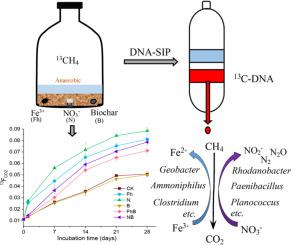Science of the Total Environment ( IF 9.8 ) Pub Date : 2021-05-15 , DOI: 10.1016/j.scitotenv.2021.147773 Dan Luo 1 , Xiangtian Meng 1 , Ningguo Zheng 1 , Yaying Li 2 , Huaiying Yao 3 , Stephen J Chapman 4

|
The anaerobic oxidation of methane (AOM) mediated by microorganisms is a key process in the reduction of methane emissions, and AOM-coupled electron acceptors have been shown to regulate methane emissions into the atmosphere in marine systems. Paddy fields are a significant source of methane and account for 20% of global methane emissions, but the effect of electron acceptors on the methane emission process in flooded paddy fields has been poorly characterized. This study aimed to determine whether the electron acceptors ferric iron and nitrate, and biochar, acting as an electron shuttle, can regulate the AOM process in paddy soil, with or without interaction between biochar and these two electron acceptors. We also aimed to characterize which microorganisms are actively involved. Here, we added 13C-labeled CH4 (13CH4) into anaerobic microcosms to evaluate the role of electron acceptors by measuring the methane oxidation rate and the enrichment of 13C-labeled CO2 (13CO2). We then combined DNA-stable isotope probing with amplicon sequencing to study the active microorganisms. We found for the first time that, in addition to nitrate, ferric iron can also effectively promote AOM in paddy soil. However, there was no significant effect of biochar. Ferric iron-dependent AOM was mainly carried out by iron-reducing bacteria (Geobacter, Ammoniphilus and Clostridium), and nitrate-dependent AOM was mainly by nitrate-reducing bacteria (Rhodanobacter, Paenibacillus and Planococcus). Our results demonstrate that the AOM process, regulated by the electron acceptors ferric iron and nitrate, can alleviate methane emission from paddy soil. The potentially active microorganisms related to electron acceptor reduction may be crucial for this methane sink and deserve further research.
中文翻译:

铁和硝酸铁对稻田甲烷的厌氧氧化作用及其所涉及的微生物群落
微生物介导的甲烷厌氧氧化是减少甲烷排放的关键过程,并且已证明AOM耦合电子受体可调节海洋系统向大气中的甲烷排放。稻田是甲烷的重要来源,占全球甲烷排放量的20%,但是电子受体对水淹稻田甲烷排放过程的影响知之甚少。这项研究旨在确定电子受体三价铁和硝酸盐以及生物炭是否充当电子穿梭体,可以调节稻田土壤中的AOM过程,无论生物炭与这两个电子受体之间是否相互作用。我们还旨在表征哪些微生物积极参与。在这里,我们添加了13个C标记的CH将4(13 CH 4)转化为厌氧微观世界,以通过测量甲烷的氧化速率和13 C标记的CO 2(13 CO 2)的富集来评估电子受体的作用。然后,我们将DNA稳定同位素探测与扩增子测序相结合,以研究活性微生物。我们首次发现,除硝酸盐外,三价铁还可以有效促进稻田土壤中的AOM。但是,生物炭没有明显的作用。依赖铁的铁的AOM主要由还原铁细菌(Geobacter,Ammoniphilus和梭状芽胞杆菌)进行),而依赖硝酸盐的AOM主要是由减少硝酸盐的细菌(罗丹杆菌,杆状芽孢杆菌和浮球菌)引起的。我们的结果表明,由电子受体铁和硝酸盐调节的AOM过程可以减轻稻田土壤甲烷的排放。与电子受体还原有关的潜在活性微生物可能对该甲烷沉陷至关重要,值得进一步研究。


























 京公网安备 11010802027423号
京公网安备 11010802027423号